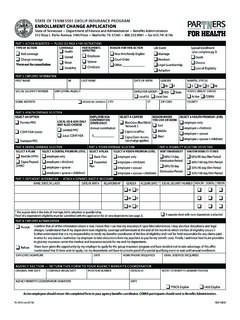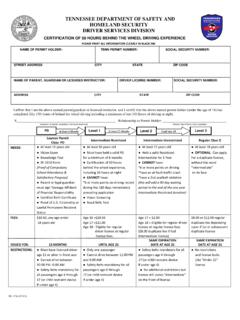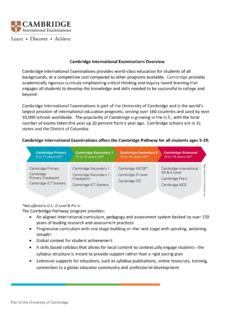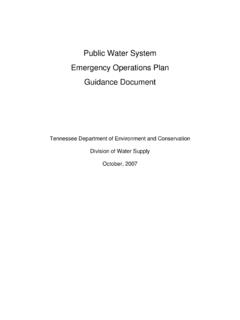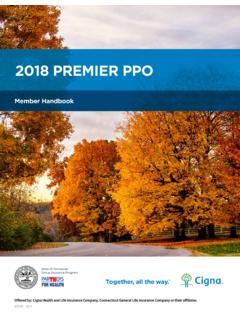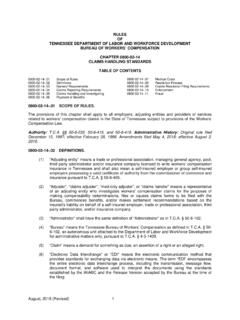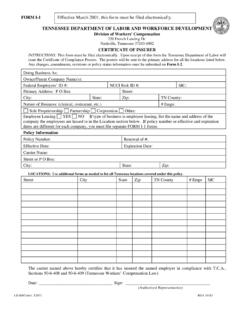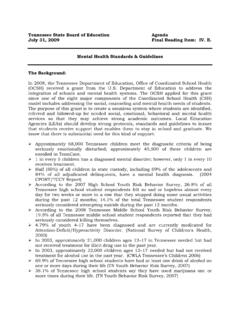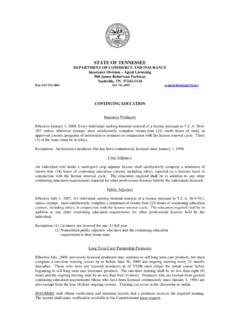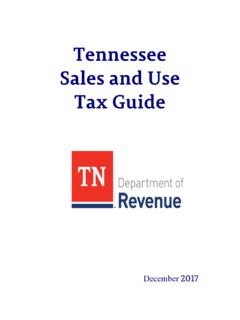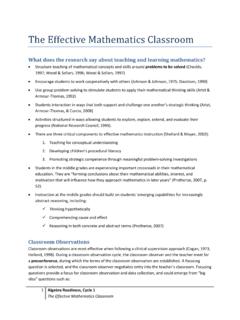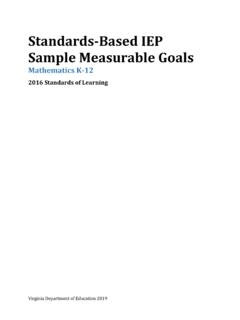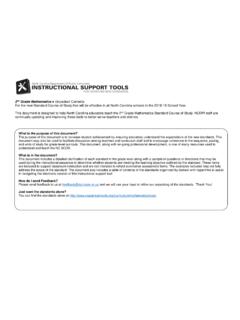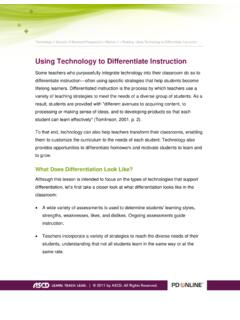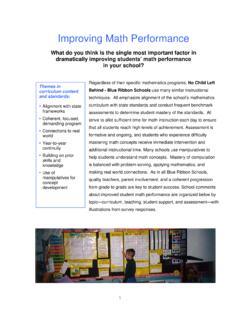Transcription of Grade 7 Mathematics Instructional Focus Documents
1 Seventh Grade Mathematics Instructional Focus Documents Introduction: The purpose of this document is to provide teachers a resource which contains: The Tennessee Grade -level Mathematics standards Evidence of Learning Statements for each standard Instructional Focus Statements for each standard Evidence of Learning Statements: The evidence of learning statements are guidance to help teachers connect the Tennessee Mathematics Standards with evidence of learning that can be collected through classroom assessments to provide an indication of how students are tracking towards Grade -level conceptual understanding of the Tennessee Mathematics Standards.
2 These statements are divided into four levels. These four levels are designed to help connect classroom assessments with the performance levels of our state assessment. The four levels of the state assessment are as follows: Level 1: Performance at this level demonstrates that the student has a minimal understanding and has a nominal ability to apply the Grade -/course-level knowledge and skills defined by the Tennessee academic standards. Level 2: Performance at this level demonstrates that the student is approaching understanding and has a partial ability to apply the Grade -/course- level knowledge and skills defined by the Tennessee academic standards.
3 Level 3: Performance at this level demonstrates that the student has a comprehensive understanding and thorough ability to apply the Grade -/course-level knowledge and skills defined by the Tennessee academic standards. Levels 4: Performance at these levels demonstrates that the student has an extensive understanding and expert ability to apply the Grade -/course-level knowledge and skills defined by the Tennessee academic standards. The evidence of learning statements are categorized in the same way to provide examples of what a student who has a particular level of conceptual understanding of the Tennessee Mathematics Standards will most likely be able to do in a classroom setting.
4 Instructional Focus Statements: Instructional Focus statements provide guidance to clarify the types of instruction that will help a student progress along a continuum of learning. These statements are written to provide strong guidance around Tier I, on- Grade level instruction. Thus, the Instructional Focus statements are written for levels 3 and 4. Revised July 31, 2019 1 Ratios and Proportional Relationships (RP) Standard (Major Work of the Grade ) Compute unit rates associated with ratios of fractions, including ratios of lengths, areas, and other quantities measured in like or different units.
5 For example, if a person walks 1/2 mile in each 1/4 hour, compute the unit rate as the complex fraction 1/2/1/4 miles per hour, equivalently 2 miles per hour. Evidence of Learning Statements Students with a level 1 understanding of this standard will most likely be able to: Students with a level 2 understanding of this standard will most likely be able to: Students with a level 3 understanding of this standard will most likely be able to: Students with a level 4 understanding of this standard will most likely be able to: Choose a unit rate to represent a ratio presented as a complex fraction given a visual model.
6 Choose a unit rate to model situations involving whole number quantities. Choose a unit rate to model situations involving fractional quantities presented as a non-simplified complex fraction. Write ratios to model situations involving whole number quantities measured in like or different units and use the ratio to determine a unit rate. Write ratios to model situations involving fractional quantities measured in like or different units and use the ratio to determine a unit rate. Write ratios that model situations involving fractional quantities measured in like or different units, use the ratio to determine a unit rate, and explain the unit rate in terms of the context of the situation.
7 Create contextual problems that model situations involving fractional quantities measured in like or different units and provide the unit rate solution. Instructional Focus Statements Level 3: The Focus of this standard is extending a students understanding of unit rates developed in Grade 6 ( ) to computing unit rates using ratios from fractional quantities known as complex fractions. Students developed an understanding of quotients of fractions in In Grade 7, students will utilize this understanding to compute unit rates from fractional quantities. Students should discover that computing unit rates with fractions is the same concept as unit rates with whole numbers.
8 To enhance the foundational understanding of ratios as division of fractions, students should be encouraged to use visual representations or manipulatives to model the fractional quantities in order to compute a unit rate. Students may have misconceptions when writing a ratio in the form of a complex fraction. It is important for students to understand that the fraction bar is the same as the common division Revised July 31, 2019 2 symbol. Also, students should make connections to visual models to grasp the fractional unit rate. Using the example from the standard, students should utilize a visual representation (number line, bar graph, etc.)
9 To see that if a person walks 1/2 mile every 1/4 hour, results in 4 of the 1/2 miles in a total hour, which is equivalently a unit rate of 2 miles per hour. Students should explain their reasoning about computing unit rates with complex fractions with like and different units, including identifying when errors can be presented. Level 4: Students should extend their understanding of computing unit rates associated with ratios of fractions to make connections between visual representations and verbal descriptions. This should be explained by using precise mathematical language. Students should also be well versed in working with like and different units and make sense of contextual problems (MP1) to determine when errors or misconceptions could be made.
10 Additionally, students be able to translate their understanding to create contextual problems that model situations involving fractional quantities measured in like or different units and use the ratio to determine a unit rate. Revised July 31, 2019 3 Standard (Major Work of the Grade ) Recognize and represent proportional relationships between quantities. Identify the constant of proportionality (unit rate) in tables, graphs, equations, diagrams, and verbal descriptions of proportional relationships. Evidence of Learning Statements Students with a level 1 understanding of this standard will most likely be able to: Students with a level 2 understanding of this standard will most likely be able to: Students with a level 3 understanding of this standard will most likely be able to: Students with a level 4 understanding of this standard will most likely be able to: Choose the constant of proportionality (unit rate) when given a graph.
